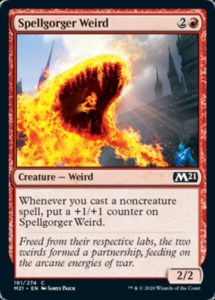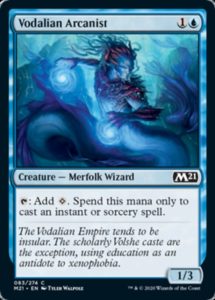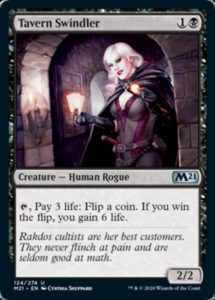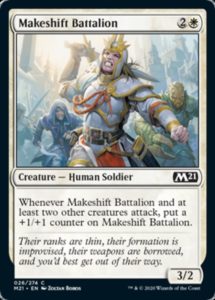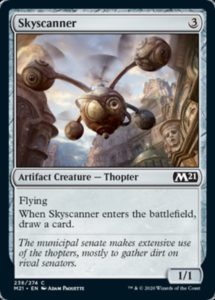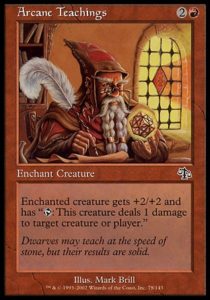With Core Set 2021’s paper release imminent and digital release well underway, there’s a whole lot to pay attention to. New Standard and Limited environments to explore, a plethora of desired reprints, new commanders, new booster fun, new takes on familiar mechanical themes, and entirely new themes like dog tribal. Today, we’ll look past all this exciting hullabaloo to focus on something you might not have noticed, but that can teach one of the most essential facts of Limited: the importance of context.
Every Limited format has attributes that make some cards stronger and others weaker. As we play, we learn these attributes and improve our evaluation of the set. We share this information, leading to formats being well understood before the next set releases. When a format returns in an Arena, Magic Online, or LGS flashback draft, the players who remember these evaluations have enormous advantages over the other players.
But sometimes, cards return in new contexts and our familiarity with them can lead us astray. A card that once was mediocre, or excellent, or unplayable could return in a new context and its radically different potency could be easy to overlook. M21 has five such cards that have surprised me. Let’s take a few minutes to consider them and when past experiences can sometimes hinder us (even when they overwhelmingly tend to help).
Well, that’s weird
Spellgorger Weird was strong when introduced in War of the Spark. It could quickly grow to prodigious sizes and threaten opposing planeswalkers. It was difficult to block when Jaya’s Greeting or Chandra’s Pyrohelix could completely ruin combat math. One would expect that it’d be even better in M21, given that it has Shock and Scorching Dragonfire alongside one mana cantrips like Opt and Crash Through and generally worse removal than WAR did. However, I’ve been underwhelmed by most weirds I’ve cast. While M21 solid spells aplenty, the dearth of token creation cards means you have to commit deck space to noncreature spells, something Amass avoided.
War of the Spark was a threat-dense format where your opponent might not have enough removal remaining to take out your weirds. Boards needed to be kept relatively clear so you could pressure opposing planeswalkers. But there are fewer must-kill threats and no uncommon planeswalkers in M21, so a Spellgorger Weird you’ve invested 3+ spells is likely to meet an unfortunate end. The ceiling is still very high on our weird friend, but the floor seems a lot lower.
Less-folk
Vodalian Arcanist was a humble but critical piece in Dominaria. It staved off early aggression, had the super relevant wizard type, and ramped out Call the Cavalry and kicked Grow from the Ashes. In M21, it has no tribal benefits, lines up worse with the set’s spells, and seems worse at stymieing aggro.
While Spellgorger Weird had a moderate shift in power level, our scholarly friend seems to have sunk very far. Now, that’s not a knock against its inclusion in the set—it’s exciting seeing how context shifts capability—but I’m definitely thinking twice before committing to spending 1U this way.
Better odds than before
In Return to Ravnica, Tavern Swindler was a Grizzly Bear. It had no real synergy, but it did let your opponent show off their luck or willingly deal nine to themselves for no benefit. She returned in Iconic Masters as a potent but nonessential piece of the WB lifegain deck. Well, there’s another lifegain deck in M21, and while the payoffs are strong, the enablers aren’t.
Core Set 2021 has no Markov Patrician to gain you exactly enough life, all by itself, without any timing or deckbuilding awkwardness. Instead, you need to commit to timing Revitalize right, overpaying on Blood Glutton, waiting until Anointed Chorister comes online (and probably dies in combat), or combining Indulging Patrician with Radiant Fountain or Light of Promise.
The enablers for WB lifegain seem so finite, finicky, and fragile that you’re better off leaving Griffin Aerie in the sideboard. Maybe Tavern Swindler is there to fill in the gaps, since if you can’t gain three life, she’ll give you a 50% of salvaging your engine when it sputters. Time will tell, and it’s weird seeing so much hinge on a coin flip, but she could be the glue that WB needs.
Makeshift Batting .500
White was the weakest color in War of the Spark. It struggled to accumulate +1/+1 counters to Proliferate, had some of the weakest planeswalkers, and lacked the strong cheap creatures necessary for enabling Makeshift Battalion. Well, Proliferate isn’t a theme in M21, but +1/+1 counters are, and Basri’s Acolyte provides a stellar reward for curving out.
Makeshift Battalion seems substantially improved from its first outing, and that’s even before considering how much less interaction there is in M21 than there was in WAR. While Spellgorger Weird and Vodalian Arcanist are weaker and Tavern Swindler merely has the potential to do good work, this soldier seems to have gotten a sizable upgrade in this new context.
Bet you thopt we’d do a green card
Setessan Training seems pretty similar to how it played in THB, which isn’t too surprising when Constellation was fairly anemic was and RG Ferocioous returns yet again in M21. Colossal Dreadmaw is still a fine and oft-reprinted creation from 2017. The rest of green’s common reprints are mostly lower tier playables and sideboard cards. There don’t seem to be many context changes, which perhaps isn’t surprising when most of these reprints don’t slot into green’s archetypes (then or now).
But on the colorless front, Skyscanner was solid in M19 and now seems to be coming up short. It works well in the sacrifice deck and ought to function well in WU Skies; but there is no Favorable Winds to turn it into a relevant threat, and Gnarled Sage is all too happy to eat it.
M19 had an entire archetype that rewarded having a single artifact. It also had potent removal, relatively few flying creatures, and both Marauder’s Axe and Skilled Animator to upgrade this little thopter, all which made it worth putting three mana into this. Now, I’m not saying Skyscanner is a bad card (it’s hard for anything that cantrips to be awful), but it’s been a lot less impressive in its first outings. It’s great at making your opponent feel bad for playing a 2/1, but those don’t seem particularly playable anyway, and when cheap creatures are being played, they’re often getting +1/+1 counters and making Skyscanner cry.
It’s an important level-up moment for players to apply principles from one format to another. To learn how different sets have different speeds, differently critical spots on the curve, different removal that dictates what is playable. Fundamentals tend to transfer from one set to another, and even from Limited to Constructed. But sometimes, old knowledge doesn’t hold true. Wild Mongrel saw loads of play but Noose Constrictor saw none despite being a better card.
It’s worth checking one’s assumptions every now and then, because sometimes knowledge that once was crucial success can lead to critical handicaps. This applies in all aspects of life—what once seemed acceptable might no longer be, or have never been; what served you well with friends might fail you with family or a different group of friends—and bears keeping in mind. Life changes, as do we all, and context puts all of it in different lights. Here’s hoping we can get better at noticing when things change as well as when they stay the same.
And, as always, thanks for reading.
—Zachary Barash is a New York City-based game designer and the commissioner of Team Draft League. He designs for Kingdom Death: Monster, has a Game Design MFA from the NYU Game Center, and does freelance gatame design. When the stars align, he streams Magic (but the stars align way less often than he’d like).

